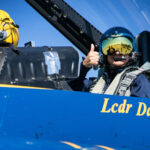The world’s fastest flying bird is the Peregrine Falcon, renowned for its incredible speeds during hunting dives. Are you fascinated by avian speed and aerial prowess? At flyermedia.net, we delve into the world of flight, exploring the remarkable adaptations and ecological pressures that drive birds to achieve breathtaking velocities. Join us as we uncover the secrets of the fastest birds, providing insights for aviation enthusiasts, nature lovers, and anyone curious about the wonders of the natural world. Dive into the world of ornithology, avian biology, and high-speed flight.
1. Understanding Avian Speed: What Makes a Bird Fast?
Avian speed is determined by a combination of factors, including body structure, wing shape, muscle power, and ecological pressures. How do these elements work together to enable birds to reach such impressive velocities?
Birds have evolved over millions of years to master the art of flight, with natural selection favoring traits that enhance their aerial abilities. According to research from Embry-Riddle Aeronautical University, these adaptations include:
- Streamlined Body: Reduces air resistance, allowing for more efficient movement through the air.
- Lightweight Bones: Reduces overall weight, making it easier to achieve and maintain high speeds.
- Powerful Muscles: Especially the pectoral muscles, provide the necessary force for rapid wing movements.
- Aerodynamic Wings: Long, pointed wings reduce drag and increase lift, optimizing flight performance.
- Efficient Respiratory System: Provides a continuous flow of oxygen to support the high metabolism required for sustained flight.
These adaptations, combined with ecological pressures such as hunting and predator avoidance, have driven the evolution of exceptional speed in certain bird species.
2. The Peregrine Falcon: The Undisputed Speed Champion
The Peregrine Falcon is the fastest animal on Earth, capable of reaching speeds exceeding 240 mph (386 kph) during its hunting stoop. What makes this bird so uniquely adapted for high-speed flight?
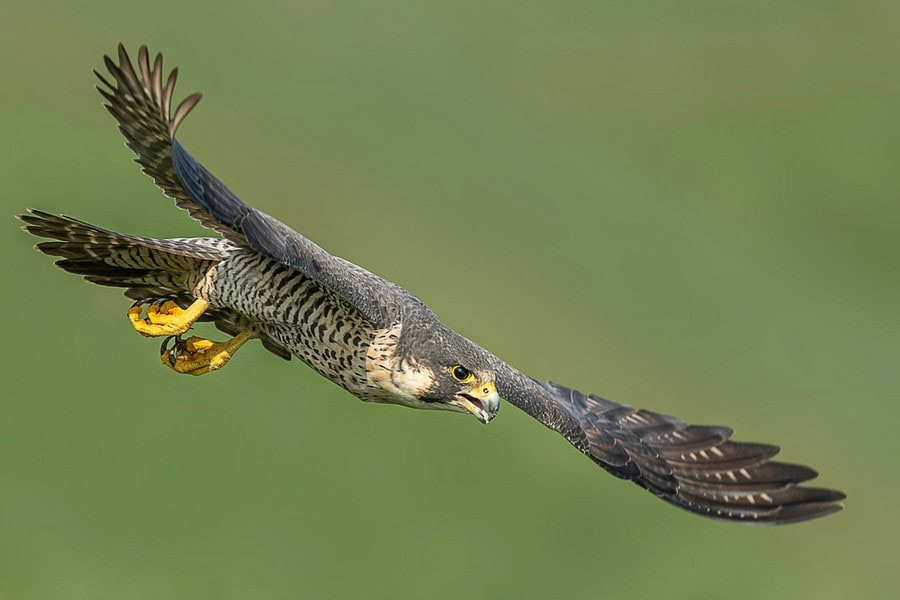 Peregrine Falcon Hunting Stoop
Peregrine Falcon Hunting Stoop
The Peregrine Falcon’s incredible speed is a result of several key adaptations:
- Aerodynamic Design: Its streamlined body and pointed wings minimize air resistance, allowing it to cut through the air with ease.
- Strong Heart and Muscles: Its powerful heart and flight muscles provide the necessary power for rapid acceleration and sustained high-speed flight.
- Specialized Nostrils: These control airflow during high-speed dives, preventing lung damage.
- Keen Eyesight: Allows it to spot prey from great distances and accurately track its movements during the stoop.
Peregrine Falcons are found on every continent except Antarctica, adapting to a wide range of environments, from urban centers to coastal areas. Their diet consists mainly of medium-sized birds, which they strike mid-air to stun or kill before catching them. Their hunting technique and physical adaptations make them the undisputed speed champions of the avian world.
3. Diving Deep: How the Peregrine Falcon Achieves Such High Speeds
The Peregrine Falcon’s hunting stoop is a marvel of natural engineering, involving a complex sequence of movements and physiological adaptations. How does the falcon execute this high-speed dive with such precision and control?
The hunting stoop typically begins with the falcon ascending to a great height, sometimes several thousand feet above its prey. Once it spots a target, the falcon initiates its dive, tucking its wings close to its body to reduce drag and increase speed. As it plummets towards its prey, the falcon’s specialized nostrils regulate airflow, preventing lung damage from the intense pressure. According to the FAA, Peregrine Falcons can reach speeds of over 200 mph in just a few seconds during their dives.
At the critical moment, the falcon extends its talons and strikes its prey with incredible force, often killing or stunning it instantly. The impact can generate forces of up to 25 Gs, requiring the falcon to possess exceptional strength and resilience. After the strike, the falcon either catches the falling prey in mid-air or retrieves it from the ground. The Peregrine Falcon’s hunting stoop is a testament to the power of natural selection, showcasing the remarkable adaptations that enable this bird to thrive as a top predator.
4. Other Speedsters: Birds That Give the Falcon a Run for Its Money
While the Peregrine Falcon holds the top spot, several other bird species are capable of impressive speeds in their own right. Which birds rank among the fastest in the world, and what adaptations allow them to achieve such velocities?
- Golden Eagle: Reaching speeds up to 200 mph (322 kph) during hunting dives, the Golden Eagle is one of the largest and most powerful birds of prey.
- White-Throated Needletail Swift: Clocking in at 105 mph (169 kph) in level flight, this swift is one of the fastest birds in sustained flight.
- Eurasian Hobby: With speeds of 100 mph (160 kph), this small falcon is known for its agility and acrobatic flight.
- Bald Eagle: While typically flying at slower speeds, the Bald Eagle can reach up to 99 mph (160 kph) when diving towards prey or during territorial displays.
- Frigatebird: Thanks to its large wingspan-to-body-weight ratio, Frigatebirds can glide easily and reach speeds up to 95 mph (153 kph).
- Rock Dove (Pigeon): Usually found in urban areas worldwide, pigeons are surprisingly fast, reaching speeds up to 93 mph (150 kph).
- Gyrfalcon: The largest of the falcon species, the Gyrfalcon can reach speeds up to 90 mph (145 kph) in level flight and even faster during hunting stoops.
- Spur-Winged Goose: The largest waterfowl native to Africa, the Spur-Winged Goose can reach speeds up to 88 mph (142 kph) during flight.
- Red-Breasted Merganser: This diving duck can reach speeds up to 81 mph (130 kph).
These birds demonstrate the diversity of adaptations that allow different species to thrive in a variety of ecological niches.
5. The Golden Eagle: A Majestic Hunter of the Skies
The Golden Eagle is one of the largest and most powerful birds of prey, known for its impressive size, strength, and hunting prowess. How does the Golden Eagle use its speed and agility to catch prey in diverse environments?
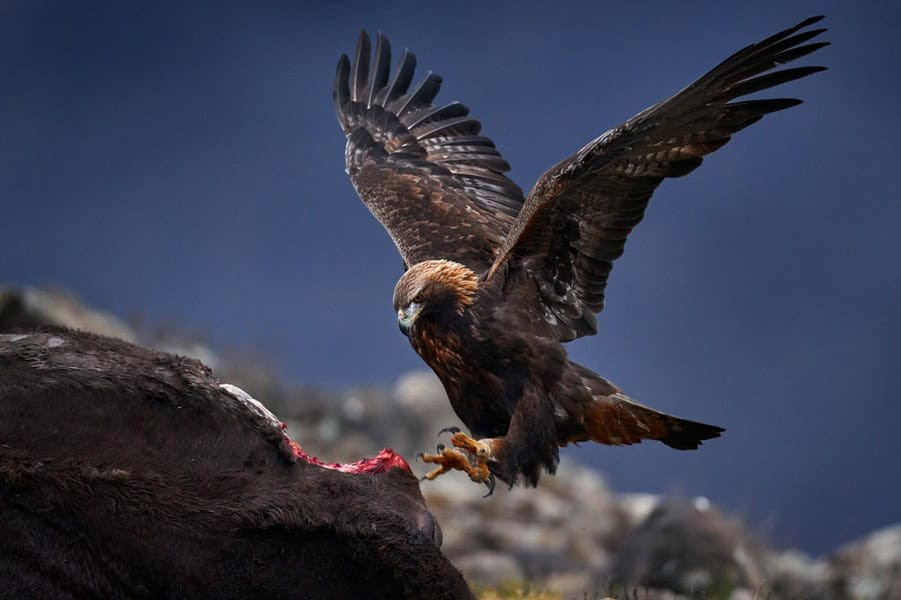 Golden Eagle in Flight
Golden Eagle in Flight
With a wingspan of up to 7 feet (2.1 meters), the Golden Eagle uses its speed to catch mammals like rabbits and marmots. Its powerful talons can exert over 400 pounds (181 kg) of pressure per square inch, allowing it to capture and dismember large prey. In hunting dives, it can reach velocities up to 200 mph (322 kph). According to the U.S. Fish and Wildlife Service, Golden Eagles have excellent vision and can maintain a steady speed while soaring, enabling them to spot prey from great distances.
Golden Eagles inhabit diverse environments, including mountains, deserts, and open plains across the Northern Hemisphere. They build large nests, often reusing them for many years. Their hunting skills and adaptability make them a keystone species in their ecosystems.
6. Swift and Sleek: The White-Throated Needletail’s Aerial Mastery
The White-Throated Needletail Swift is one of the fastest birds in level flight, spending most of its life on the wing. What unique adaptations allow this swift to maintain such high speeds for extended periods?
The White-Throated Needletail Swift reaches speeds up to 105 mph (169 kph) in level flight. This swift spends most of its life on the wing, feeding on insects caught in flight. Its robust, cigar-shaped body and long, curved wings are perfectly adapted for rapid, sustained flight. The bird’s name comes from the needle-like feathers at the end of its tail. The International Birding Association notes that this species is found in rocky hills and forests in Asia and Australia, it migrates long distances between breeding and wintering grounds.
Interestingly, needletails can even sleep while flying, only stopping to breed and raise young. Their ability to maintain high speeds for extended periods makes them a marvel of avian engineering.
7. The Eurasian Hobby: An Agile Aerial Acrobat
The Eurasian Hobby is a small, slender falcon known for its speed and acrobatic flight. How does the Hobby use its agility and quickness to hunt insects and small birds in mid-air?
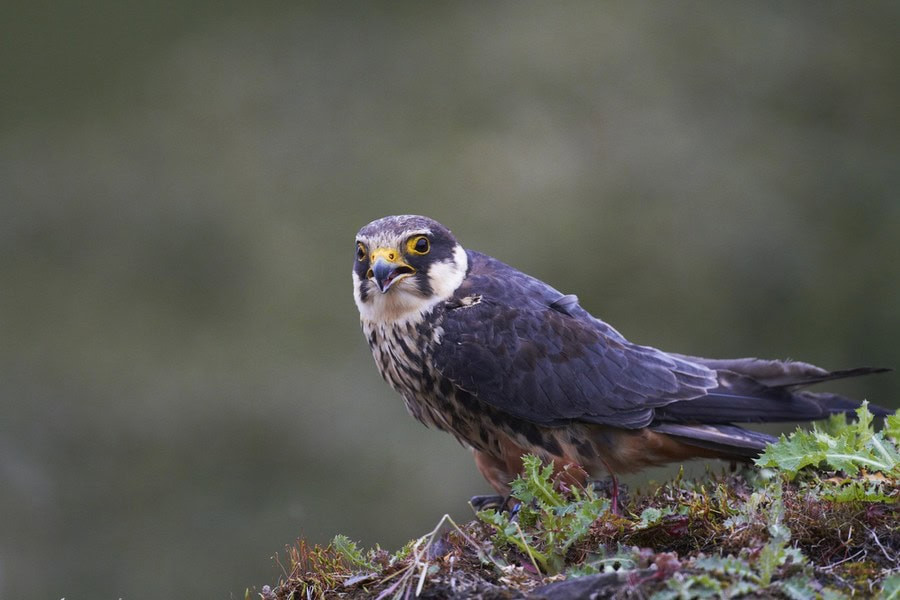 Eurasian Hobby Hunting
Eurasian Hobby Hunting
Capable of reaching speeds of 100 mph (160 kph), the Eurasian Hobby hunts insects and small birds. Its agility and quickness make it a master of aerial pursuit. The hobby has slate-grey upperparts and distinctive red “trousers” on its legs. It breeds across Europe and Asia, migrating to Africa and southern Asia in winter. According to the Royal Society for the Protection of Birds, the Eurasian hobby often hunts at dusk, taking advantage of insect swarms, and is sometimes seen chasing swifts and swallows.
Their hunting skills and acrobatic abilities make them a formidable predator in the skies.
8. Bald Eagle: A Symbol of Speed and Power
The Bald Eagle, a symbol of the United States, is known for its majestic appearance and powerful flight. How does the Bald Eagle use its speed and strength to catch fish and other prey?
While typically flying at slower speeds, the Bald Eagle can reach up to 99 mph (160 kph) when diving toward prey or during territorial displays. With a wingspan of up to 8 feet (2.4 meters), it soars effortlessly on thermal currents while scanning for fish and small mammals. The bald eagle is a symbol of the United States and was once endangered due to habitat loss, hunting, and pesticide use. According to the National Audubon Society, conservation efforts, including the banning of DDT, have helped their populations recover significantly.
Bald eagles build enormous nests, some weighing over a ton, which they often reuse and add to each year. Their combination of speed, strength, and keen eyesight makes them a formidable predator in their ecosystems.
9. Frigatebird: A Master of Gliding and Aerial Piracy
Frigatebirds are seabirds with the largest wingspan-to-body-weight ratio of any bird, allowing them to glide easily and reach impressive speeds. How do Frigatebirds use their speed and agility to steal food from other birds in mid-flight?
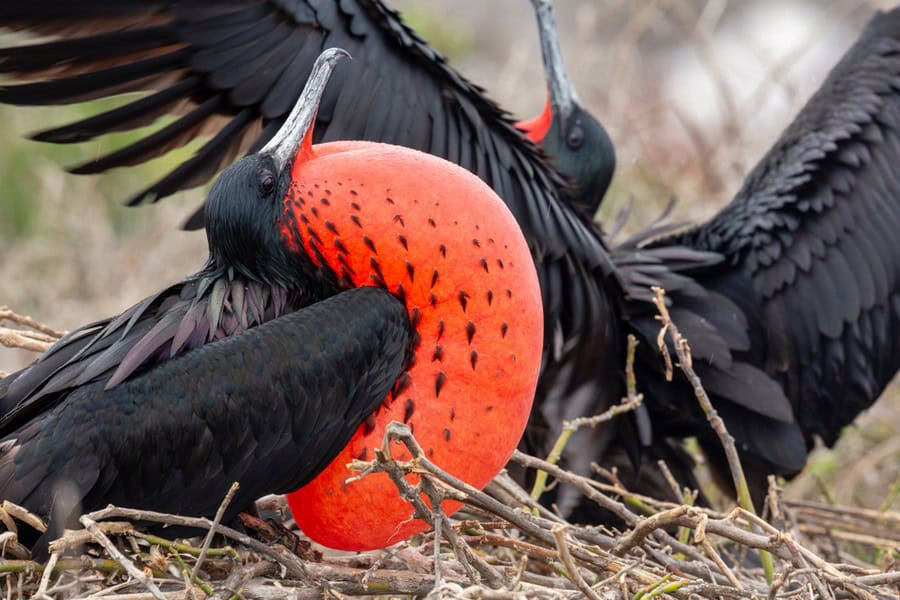 Frigatebird in Flight
Frigatebird in Flight
Frigatebirds are seabirds with the largest wingspan-to-body-weight ratio of any bird, allowing them to glide easily and reach speeds up to 95 mph (153 kph). Known for their kleptoparasitic behavior, they often steal food from other birds mid-flight by harassing them until they regurgitate their catch. Frigatebirds have long, hooked bills and a distinctive forked tail. Males display a red gular pouch during courtship, inflating it to attract females. According to the Cornell Lab of Ornithology, frigatebirds are found over tropical and subtropical oceans, they spend days and nights on the wing, landing only to breed or rest on remote islands.
Their unique hunting behavior and physical adaptations make them a fascinating species to study.
10. Rock Dove (Pigeon): The Urban Speedster
The Rock Dove, commonly known as the pigeon, is a familiar sight in urban areas worldwide. Despite its humble appearance, the pigeon is surprisingly fast. How have humans utilized the pigeon’s speed and homing ability throughout history?
Usually found in urban areas worldwide, pigeons are surprisingly fast, reaching speeds up to 93 mph (150 kph). Their speed and homing ability have been utilized by humans for message delivery throughout history, notably in wartime communications. Rock doves have a stout body and short neck, with variable plumage but often displaying iridescent feathers on the neck and wings. According to the American Ornithological Society, pigeons have been subjects of scientific research in studies on navigation, learning, and genetics, including work by Charles Darwin on natural selection.
Their speed, adaptability, and homing ability have made them a valuable asset to humans for centuries.
11. Gyrfalcon: Arctic Hunter of the Falcon Family
The Gyrfalcon is the largest of the falcon species, inhabiting Arctic and sub-Arctic regions. How does the Gyrfalcon use its speed and endurance to pursue prey over long distances in harsh environments?
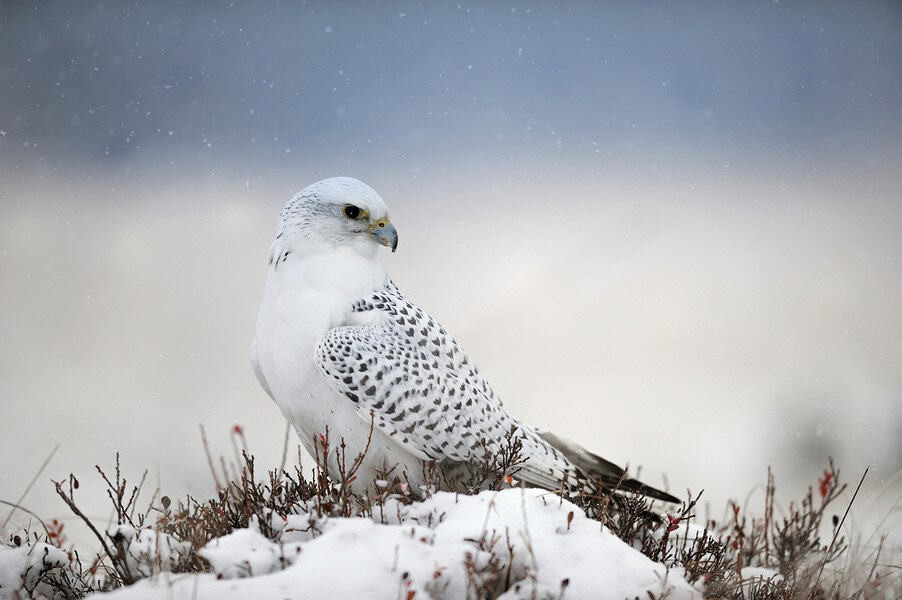 Gyrfalcon in Arctic Environment
Gyrfalcon in Arctic Environment
The gyrfalcon is the largest of the falcon species, inhabiting Arctic and sub-Arctic regions. It can reach speeds up to 90 mph (145 kph) in level flight and even faster during hunting stoops. Its powerful build and endurance allow it to pursue prey over long distances in harsh, open environments. The gyrfalcon preys primarily on ptarmigan and seabirds, which it captures in mid-air or on the ground. According to the Arctic Institute, it exhibits a variety of color morphs, from pure white to dark gray, providing camouflage against the snowy landscapes.
Historically, gyrfalcons were highly prized in falconry by nobility due to their rarity and hunting prowess.
12. Spur-Winged Goose: A Toxic Speedster of Africa
The Spur-Winged Goose is the largest waterfowl native to Africa, known for its impressive size and unique defense mechanisms. How does the Spur-Winged Goose achieve high speeds despite its size, and what makes its flesh poisonous to predators?
The spur-winged goose is the largest waterfowl native to Africa, reaching weights of up to 17 pounds (7.7 kilograms). Despite its size, it can reach speeds up to 88 mph (142 kph) during flight. Its powerful wings enable it to cover long distances between feeding and breeding grounds. The goose is named for the sharp spurs on its wings, which it uses for defense and dominance displays. According to research published in the Journal of African Ecology, uniquely, it feeds on toxic blister beetles, accumulating cantharidin in its tissues, making its flesh poisonous to predators and humans.
The spur-winged goose inhabits wetlands and grasslands, often forming flocks outside the breeding season.
13. Red-Breasted Merganser: A Versatile Aquatic Hunter
The Red-Breasted Merganser is a diving duck known for its slender body, rapid wingbeats, and serrated bill. How does the Red-Breasted Merganser use its speed and agility to hunt fish in both freshwater and coastal environments?
 Red-Breasted Merganser in Water
Red-Breasted Merganser in Water
This diving duck can reach speeds up to 81 mph (130 kph). Its slender body and rapid wingbeats are well-adapted for swift flight over lakes and coastal waters. The red-breasted merganser has a distinctive spiky crest and a long, serrated bill ideal for catching fish. It dives underwater, propelling itself with powerful webbed feet to chase prey. Found across North America and Eurasia, it breeds in freshwater lakes and winters along coastlines. The North American Breeding Bird Survey indicates that the merganser’s ability to both fly and swim rapidly makes it a versatile and efficient hunter in aquatic environments.
Their hunting skills and adaptability make them a successful predator in a variety of aquatic habitats.
14. Grey-Headed Albatross: A Long-Distance Gliding Champion
The Grey-Headed Albatross is known for its long-distance flights over the open ocean, utilizing dynamic soaring to travel vast distances with minimal energy expenditure. How does the Grey-Headed Albatross achieve such high speeds and endurance in its pelagic lifestyle?
The grey-headed albatross is known for its long-distance flights over the open ocean, reaching speeds of 79 mph (127 kph). It utilizes dynamic soaring, exploiting wind gradients over the waves to travel vast distances with minimal energy expenditure. With a wingspan of about 7 feet (2.2 meters), it can glide for hours without flapping. The albatross feeds mainly on squid and fish, often following ships to scavenge scraps. According to the British Antarctic Survey, breeding on isolated sub-Antarctic islands, it nests on steep slopes and cliffs.
Their ability to glide for extended periods and travel vast distances makes them a marvel of avian endurance.
15. Canvasback: A North American Diving Duck
The Canvasback is a North American diving duck recognized by its long, sloping forehead and reddish-brown head in males. How does the Canvasback use its speed and streamlined body to navigate and forage in prairie potholes and coastal bays?
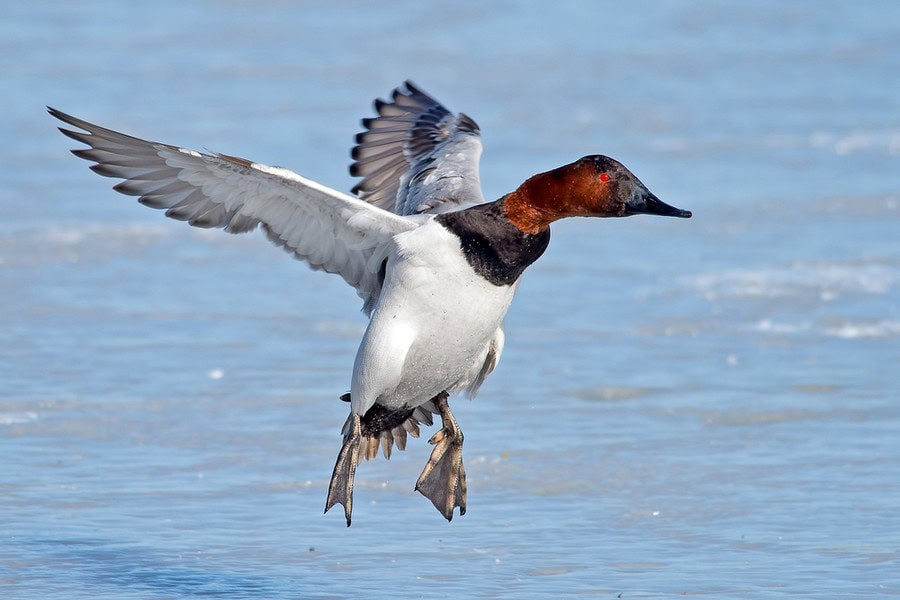 Canvasback Duck
Canvasback Duck
The canvasback is a North American diving duck recognized by its long, sloping forehead and reddish-brown head in males. It reaches flight speeds of up to 73 mph (117 kph), enabled by its streamlined body and powerful wings. Canvasbacks breed in prairie potholes and marshes, preferring areas with abundant aquatic vegetation. They migrate to coastal bays and large lakes in winter, forming large flocks. According to Ducks Unlimited, their diet consists of tubers, seeds, and invertebrates.
Their streamlined body and powerful wings allow them to thrive in a variety of aquatic environments.
16. Mallard: A Common and Adaptable Wild Duck
The Mallard is a common wild duck found across the Northern Hemisphere, known for its adaptability and strong flight capabilities. How does the Mallard use its speed and endurance to travel long distances during migration?
The mallard is a common wild duck found across the Northern Hemisphere. Mallards are strong fliers, capable of reaching flight speeds of up to 65 mph (105 kph). It travels long distances during migration, sometimes covering 800 miles (1,287 kilometers) in a single day. The male is easily recognized by its glossy green head, white neck ring, and chestnut-brown chest, while the female is mottled brown for camouflage. According to the U.S. Geological Survey, they inhabit a wide range of habitats, including wetlands, rivers, ponds, and urban parks.
Mallards are omnivorous, feeding on seeds, aquatic vegetation, insects, and small fish. They are the ancestors of most domestic duck breeds.
17. Anna’s Hummingbird: A Tiny Speedster with a Daring Dive
Anna’s hummingbirds are small but incredibly fast, especially during their courtship displays. How does the Anna’s Hummingbird use its speed and agility to attract mates and defend its territory?
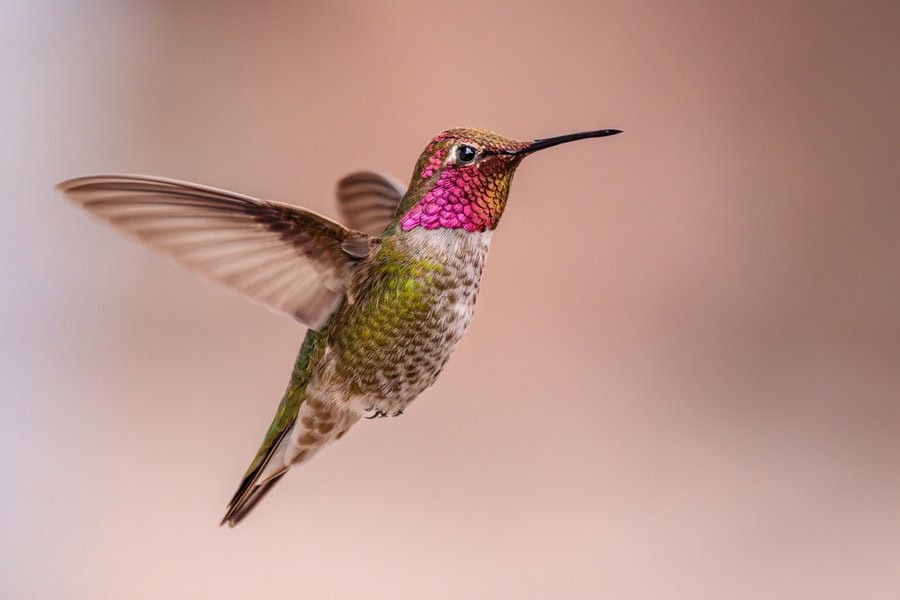 Anna's Hummingbird
Anna's Hummingbird
Anna’s hummingbirds are small but incredibly fast, especially during their courtship displays. Males climb up to 130 feet (40 meters) before diving toward the ground, reaching speeds of 61 mph (98 kph). Their wings beat up to 80 times per second, enabling them to hover and maneuver with precision. Native to the western coast of North America, they have iridescent emerald feathers and a rose-pink throat patch called a gorget. According to the Smithsonian National Museum of Natural History, these hummingbirds feed on nectar and insects.
Despite their tiny size, they are known to be territorial and can aggressively defend feeding areas.
18. Great Snipe: A Long-Distance Migratory Champion
The Great Snipe is known for its fast migration speeds, flying non-stop over vast distances between its breeding and wintering grounds. How does the Great Snipe achieve such high speeds and endurance during its long-distance migrations?
The great snipe is known for its fast migration speeds, flying non-stop over 4,200 miles (6,760 kilometers) from northern Europe to sub-Saharan Africa at speeds around 60 mph (97 kph). Its rapid, direct flight helps it avoid predators during these long journeys. The great snipe has a stocky build with cryptic plumage that blends into marshy and grassland habitats. According to BirdLife International, during the breeding season, males perform elaborate display flights and ground dances, accompanied by distinctive clicking and drumming sounds to attract females.
Their migratory prowess makes them a champion of long-distance flight.
19. Comparing the Speed of Modern and Prehistoric Birds
Scientists have long debated the flight capabilities of prehistoric birds, comparing their skeletal features and estimated muscle mass to those of modern birds. Were prehistoric birds faster than their modern counterparts?
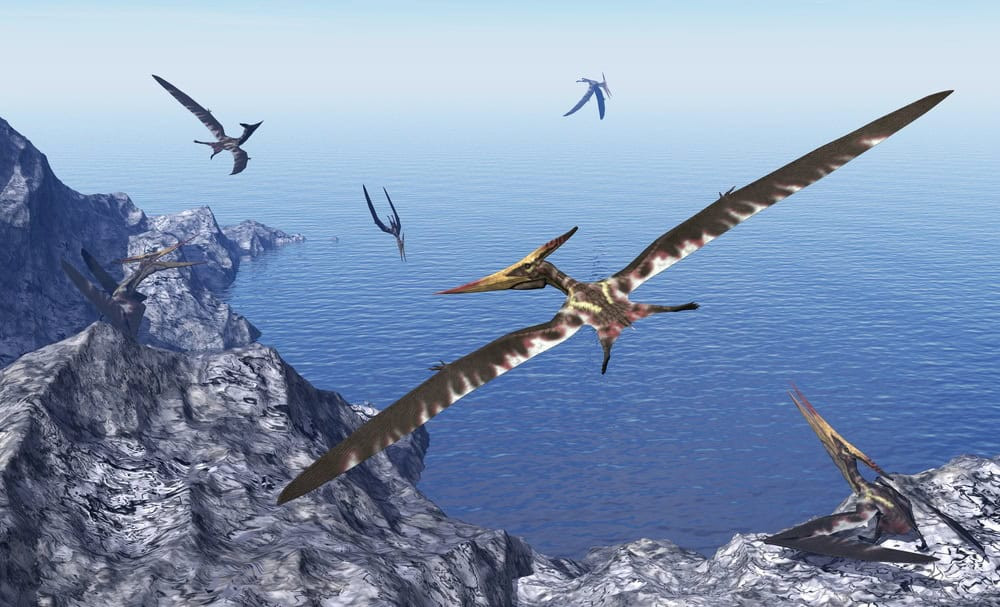 Prehistoric Bird Reconstruction
Prehistoric Bird Reconstruction
Researchers often compare the skeletal features of prehistoric birds to those of modern birds with known speeds. Paleontologists employ computer modeling to recreate possible flight patterns using inputs such as weight, wingspan, and estimated muscle mass. The results typically indicate moderate speeds. While large ancient birds were impressive in size, they seem to be built for stable, sustained flight rather than speed.
The speed of modern birds is aided by compact bodies and aerodynamic shapes. Ancient giants lacked such adaptations. Large wings and heavy bones generally reduce top speeds. Over millions of years, birds evolved specialized wing shapes, hollow bones, and strong breast muscles. These refinements paved the way for fast flying. As a result, most evidence suggests they would not exceed the fastest speeds seen in living raptors.
20. The Science of Flight: Aerodynamics and Bird Speed
Aerodynamics plays a crucial role in determining the speed and efficiency of bird flight. How do wing shape, air resistance, and lift contribute to a bird’s ability to fly at high speeds?
Aerodynamics is the study of how air moves around objects, and it is essential for understanding bird flight. The shape of a bird’s wings is designed to create lift, which counteracts gravity and allows the bird to stay airborne. Air resistance, also known as drag, opposes the bird’s movement through the air and reduces its speed. According to a study published in the Journal of Experimental Biology, birds with long, pointed wings experience less drag and can fly at higher speeds than birds with short, rounded wings.
The angle of attack, which is the angle between the wing and the oncoming airflow, also affects lift and drag. Birds can adjust their angle of attack to optimize their flight performance in different conditions. The combination of wing shape, air resistance, and lift determines a bird’s ability to fly at high speeds and maintain sustained flight.
21. Ecological Pressures: How Hunting and Predation Drive Speed
Ecological pressures, such as hunting and predation, have played a significant role in the evolution of speed in birds. How do these pressures drive natural selection and lead to the development of faster flight capabilities?
Ecological pressures are the environmental factors that affect an organism’s survival and reproduction. Hunting and predation are two of the most important ecological pressures for birds. Predatory birds, such as falcons and eagles, rely on speed to catch prey. Conversely, smaller birds need speed to escape predators. According to research from the University of Oxford, natural selection favors traits that improve aerial abilities, such as lighter bones, stronger muscles, and more aerodynamic wings.
Over time, these adaptations become more pronounced, leading to the evolution of exceptional speed in certain bird species. The constant struggle for survival drives the evolution of faster flight capabilities, allowing birds to thrive in their respective ecological niches.
22. Human Impact: How Conservation Efforts Affect Bird Populations
Human activities, such as habitat destruction, hunting, and pesticide use, have had a significant impact on bird populations around the world. How do conservation efforts help protect birds and their habitats, and what can individuals do to support these initiatives?
Human activities have had a devastating impact on bird populations worldwide. Habitat destruction, caused by deforestation, urbanization, and agriculture, reduces the available space for birds to live and breed. Hunting and poaching can decimate bird populations, particularly those of endangered species. Pesticide use can poison birds directly or indirectly through their food sources. According to the International Union for Conservation of Nature (IUCN), many bird species are threatened with extinction due to human activities.
Conservation efforts, such as habitat restoration, captive breeding programs, and anti-poaching patrols, can help protect birds and their habitats. Individuals can support these initiatives by reducing their carbon footprint, supporting sustainable agriculture, and donating to conservation organizations. By working together, we can help ensure that birds continue to thrive for generations to come.
23. The Future of Flight: Emerging Technologies and Avian Inspiration
Emerging technologies, such as drones and advanced materials, are inspired by the principles of avian flight. How can these technologies be used to improve our understanding of bird flight and develop more efficient aircraft?
Emerging technologies are revolutionizing our understanding of bird flight and inspiring the development of more efficient aircraft. Drones equipped with cameras and sensors can be used to study bird behavior in the wild, providing valuable insights into their flight patterns and hunting strategies. Advanced materials, such as carbon fiber and composites, can be used to create lighter and stronger aircraft, mimicking the lightweight bones and powerful muscles of birds. According to a report by NASA, these technologies can be used to improve the fuel efficiency and maneuverability of aircraft, reducing their environmental impact and enhancing their performance.
By studying the principles of avian flight, we can develop innovative technologies that benefit both humans and the environment.
24. Careers in Aviation: Opportunities for Bird Enthusiasts
For those passionate about birds and aviation, numerous career opportunities exist in fields such as ornithology, aviation engineering, and wildlife conservation. What are some of the career paths available for bird enthusiasts, and what skills and qualifications are required for these roles?
For bird enthusiasts with a passion for aviation, numerous career opportunities exist in fields such as ornithology, aviation engineering, and wildlife conservation. Ornithologists study birds in their natural habitats, conducting research on their behavior, ecology, and evolution. Aviation engineers design and develop aircraft, drawing inspiration from the principles of avian flight. Wildlife conservationists work to protect birds and their habitats, implementing conservation strategies and educating the public about the importance of biodiversity. According to the Bureau of Labor Statistics, these careers typically require a bachelor’s or master’s degree in a related field, as well as strong analytical, communication, and problem-solving skills.
By pursuing a career in these fields, bird enthusiasts can combine their passion for birds with their interest in aviation, making a positive impact on the world.
25. Flyermedia.net: Your Gateway to Aviation Knowledge
At flyermedia.net, we provide a wealth of information about aviation, including articles on bird flight, aviation technology, and career opportunities in the aviation industry. How can flyermedia.net help you explore your interest in aviation and pursue your dreams of flying?
At flyermedia.net, we are dedicated to providing comprehensive and up-to-date information about all aspects of aviation. Our articles cover a wide range of topics, from the science of bird flight to the latest advancements in aviation technology. We also offer resources for those interested in pursuing a career in aviation, including information about flight schools, pilot training programs, and job opportunities in the aviation industry. Whether you are a seasoned aviation professional or a curious beginner, flyermedia.net has something to offer you.
Visit flyermedia.net today to explore the world of aviation and discover the many exciting opportunities that await you. Discover more about flight training, aviation news, and career prospects at flyermedia.net.
Ready to take your passion for aviation to new heights?
- Explore flight training programs: Find the perfect school to start your journey.
- Stay updated with aviation news: Get the latest industry insights and updates.
- Discover career opportunities: Learn about various roles and how to pursue them.
Visit flyermedia.net now and turn your aviation dreams into reality Address: 600 S Clyde Morris Blvd, Daytona Beach, FL 32114, United States. Phone: +1 (386) 226-6000. Website: flyermedia.net.
FAQ: Frequently Asked Questions About the Fastest Flying Birds
1. What is the fastest flying bird in the world?
The Peregrine Falcon is the fastest flying bird, reaching speeds exceeding 240 mph (386 kph) during its hunting stoop.
2. How fast can a Golden Eagle fly?
The Golden Eagle can reach speeds up to 200 mph (322 kph) during hunting dives, making it one of the fastest birds of prey.
3. What makes the White-Throated Needletail Swift so fast?
The White-Throated Needletail Swift is one of the fastest birds in level flight, reaching speeds up to 105 mph (169 kph) thanks to its streamlined body and long, curved wings.
4. How fast can a Bald Eagle fly?
The Bald Eagle can reach speeds up to 99 mph (160 kph) when diving towards prey or during territorial displays.
5. What is kleptoparasitism, and which bird is known for it?
Kleptoparasitism is the behavior of stealing food from other animals, and Frigatebirds are known for stealing food from other birds in mid-flight.
6. How fast can a Rock Dove (Pigeon) fly?
Pigeons are surprisingly fast, reaching speeds up to 93 mph (150 kph), which is why they have been used for message delivery throughout history.
7. What is unique about the Spur-Winged Goose?
The Spur-Winged Goose feeds on toxic blister beetles, accumulating cantharidin in its tissues, making its flesh poisonous to predators and humans.
8. How does the Grey-Headed Albatross achieve long-distance flight?
The Grey-Headed Albatross utilizes dynamic soaring, exploiting wind gradients over the waves to travel vast distances with minimal energy expenditure.
9. What adaptations allow Anna’s Hummingbird to fly so fast?
Anna’s Hummingbirds can reach speeds of 61 mph (98 kph) during courtship displays, thanks to their wings beating up to 80 times per second.
10. What is the significance of the Great Snipe’s migration speed?
The Great Snipe flies non-stop over 4,200 miles (6,760 kilometers) from northern Europe to sub-Saharan Africa at speeds around 60 mph (97 kph), showcasing its remarkable endurance and migratory prowess.
